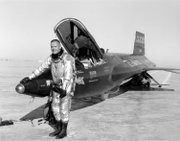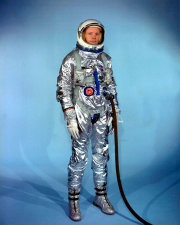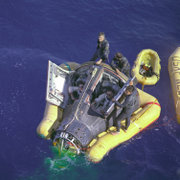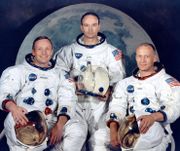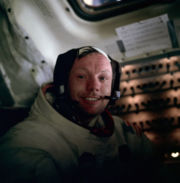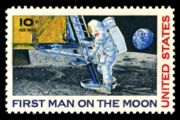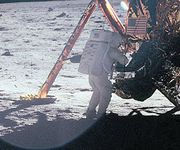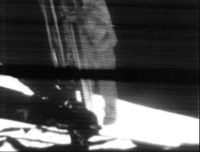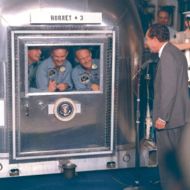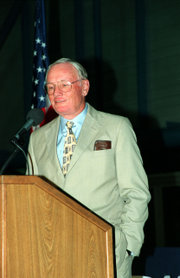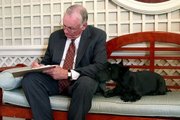Neil Armstrong
2007 Schools Wikipedia Selection. Related subjects: Geographers and explorers
 |
|
| Astronaut | |
|---|---|
| Nationality | American |
| Born | August 5, 1930 (age 76) |
| Previous occupation | Test pilot |
| Space time | 8 days, 14 hours, 10 minutes |
| Selection | MISS; Dyna-Soar; Astronaut Group 2 |
| Mission(s) | Gemini 8, Apollo 11 |
| Mission insignia |
|
Neil Alden Armstrong (born August 5, 1930) is a former American astronaut, test pilot, and Naval Aviator, and was the first human to set foot on the Moon. Armstrong's first spaceflight was Gemini 8 in 1966, for which he was the command pilot. On this mission, he performed the first manned docking of two spacecraft together with pilot David Scott. Armstrong's second and last spaceflight was as mission commander of the Apollo 11 moon landing mission on July 20, 1969. On this famous "giant leap for mankind", Armstrong and Buzz Aldrin descended to the lunar surface and spent 2.5 hours exploring, while Michael Collins orbited above.
Before becoming an astronaut, he was an aviator for the United States Navy, seeing action in the Korean War. Following this he became a test pilot at the NACA High-Speed Flight Station, now known as the Dryden Flight Research Centre, where he flew over 900 flights in a variety of aircraft. As a research pilot, Armstrong served as project pilot on the F-100 Super Sabre A and C aircraft, F-101 Voodoo, and the Lockheed F-104A Starfighter. He also flew the Bell X-1B, Bell X-5, North American X-15, F-105 Thunderchief, F-106 Delta Dart, B-47 Stratojet, KC-135 Stratotanker and Paresev.
The lunar crater, Armstrong, located 50 km away from the Apollo 11 landing site, was named in his honour.
Biography
Youth
The first child of Stephen Koenig Armstrong and Viola Louise Engel, Neil Armstrong was born at 12:31 a.m. on August 4, 1930 in Wapakoneta, Ohio.
His father's last forced move was to Wapakoneta in 1944. By this time, Neil was active in the Boy Scouts and had earned the rank of Eagle Scout. As an adult he would be recognized by the Boy Scouts of America with their Distinguished Eagle Scout Award and Silver Buffalo Award. In Wapakoneta, he attended Blume High School.
College
In 1947, Armstrong began studying Aeronautical Engineering at Purdue University and received his Bachelor of Science Degree in 1955. While with NACA in California, he also attended the University of Southern California, where he earned a Master of Science degree in Aerospace Engineering. He was only the second person in his family to attend college. He was also accepted to the Massachusetts Institute of Technology (MIT), but the only engineer he knew (who had attended MIT) dissuaded him from attending, telling Armstrong that it was not necessary to go all the way to Cambridge, Massachusetts for a good education. His college tuition was paid for under the Holloway Plan, where the successful applicants committed to two years of study, followed by three years of service in the United States Navy, then completing the last two years of the degree. At Purdue, he received average marks in his subjects, with a GPA that rose and fell over the eight semesters. His best marks came in the semesters following his return from Korea. Overall, his GPA was 4.8 out of 6.0. He pledged the Phi Delta Theta fraternity after his return, where he would write and co-direct their musical as part of the all-student revue. He was also a member of Kappa Kappa Psi National Honorary Band Fraternity, Inc. The Purdue University would later honour him in late 2004 by announcing that a new engineering building would be named for him.
It was at Purdue where he met Janet Elizabeth Shearon, who was majoring in home economics. According to the two there was no real courtship and neither can remember the exact circumstances of their engagement, except that it occurred while Armstrong was working at the NACA's Lewis Flight Propulsion Laboratory. They were married on January 28, 1956 at the Congregational Church in Wilmette, Illinois. When he moved to Edwards, he lived in the bachelor quarters of the base, while Janet lived in Westwood district of Los Angeles. After one semester, they moved into a house in Antelope Valley. Janet never finished her degree, a fact she regretted later in life.
Together, Neil and Janet had three children—Eric, Karen, and Mark. In June 1961, his daughter Karen was diagnosed as suffering from a malignant tumor of the middle part of her brain stem. X-ray treatment slowed its growth but her health deteriorated to the point she could no longer walk or talk. She died of pneumonia, related to her weakened health, on January 28, 1962, the Armstrongs' wedding anniversary.
Korea
The call-up from the Navy arrived on January 26, 1949, requiring him to report to Naval Air Station Pensacola for flight training. This would last almost a year and a half, during which time he would be qualified for carrier landing aboard the USS Cabot and USS Wright. On August 12, 1950 he was informed by letter he was now a fully qualified Naval Aviator.
His first assignment was to Fleet Aircraft Service Squadron 7 at NAS San Diego (now known as NAS North Island). Two months later he was assigned to Fighter Squadron 51 (VF-51), an all-jet squadron. He would make his first flight in a jet, a F9F-2B Panther on January 5, 1951. Six months later on June 7 he made his first jet carrier landing on the USS Essex. The same week he was promoted from midshipman to ensign. By the end of month, the Essex had set sail with VF-51 aboard, bound for Korea, where they would act as ground attack aircraft.
He first saw action in the Korean War on August 29, 1951 as an escort for a photo reconnaissance plane over Songjin. And only five days later, he was shot down for the first and only time of his military career. The principal targets for the armed reconnaissance flight were freight yards and a bridge on a narrow valley road south of the village of Majon-ni west of Wonsan. While making a low bombing run at about 350 mph (560 km/h) in his F9F Panther, he was hit with anti-aircraft guns, after which his plane took a nose dive and sliced through a cable strung about 500 feet (150 m) up across the valley by the North Koreans. This sheared off an estimated six feet (2 m) of his right wing.
He was able to fly the plane back to friendly territory but due to the loss of the aileron he would not be able to land the plane safely, meaning his only option was to eject. Planning to eject over water and await rescue by navy helicopters, he flew to an airfield near Pohang. After ejecting, winds forced him back over land and Armstrong was picked up by a jeep from the airfield, driven by a roommate from flight school. It is unknown what happened to the wreckage of No. 125122 F9F-2.
Over Korea, Armstrong would fly a total of 78 missions, for a total of 121 hours in the air. Over one third of this time was in January 1952. For his service to his country, he received the Air Medal for 20 combat missions, a Gold Star for the next 20 and the Korean Service Medal and Engagement Star. He left the navy on August 23, 1952, becoming a Lieutenant, junior grade in the United States Naval Reserve. He later resigned his commission in the Naval Reserve on October 20, 1960.
Test pilot
Upon graduating from Purdue, Armstrong decided to try to become an experimental test pilot, specifically a research pilot. He applied at the National Advisory Committee for Aeronautics High-Speed Flight Station at Edwards Air Force Base. They had no positions so they passed on the application to the Lewis Flight Propulsion Laboratory in Cleveland, Ohio, where he started working in February 1955. He was there for only five months before taking a position at Edwards.
On his very first day at Edwards, he was flying. His first assignments were piloting chase planes on drops of experimental aircraft from converted bombers. He also flew the converted bombers and on one of these he had his first dangerous experience at Edwards. He was in the right-hand seat of a B-29 Superfortress on March 22, 1956 which was air-dropping a Douglas Skyrocket D-558-2. The right-hand seat pilot was in charge of the actual release, while the left-hand seat commander flew the B-29.
As they flew to 30,000 feet (9000 m) the number four engine stopped and the propeller began wind milling in the airstream. Hitting the switch that would stop the propeller spinning, Stan Butchart, in the left-hand seat found the propeller slowed but then started spinning again, this time even faster than the other engines. If it spun too fast it would fly apart. However, they needed to have an airspeed of 210 mph to launch the D-558-2 and could not land with it still attached to the belly. They nosed the aircraft down to pick up speed and launched the D-558-2. At this very instant the propeller disintegrated, with pieces going through part of the number three engine and hitting the number two engine. Butchart and Armstrong were forced to shut down the number three engine due to damage and the number one engine due to the torque it created. They managed to make a slow, circling descent from 30,000 feet and land safely.
His first flight in a rocket plane was on August 15, 1957 in the Bell X-1B to a height of 11.4 miles (18.3 km). On landing he broke the nose landing gear, though this had happened on about a dozen previous flights of the aircraft due to its design. He would first fly the North American X-15 on November 30, 1960, the first of seven times he would be at the controls. On this first flight he would reach a top altitude of 48,840 feet (14.9 km) and a top speed of Mach 1.75.
In November 1960 he was chosen to be part of the pilot consultant group for the X-20 Dyna-Soar, a program to develop a space plane that could be used for a variety of military missions. Then on March 15, 1962 he was named as one of six pilot-engineers for the project, the people who would fly the space plane when it got off the design board.
Armstrong would be involved in several incidents that would go down in Edwards's folklore or be written about by others in their memoirs. The first was an X-15 flight on April 20, 1962 when Armstrong was testing a self-adjusting control system. He first rocketed to a height of 207,000 feet (63.2 km) (the highest he flew before Gemini 8). As he descended, he kept the nose of the craft up too long and literally bounced off the atmosphere back up to 140,000 feet (42.7 km) where the atmosphere is so thin that aerodynamic surfaces have no effect on the attitude of craft. He flew past the landing field at Mach 3 and over 100,000 feet in the air. He ended up 45 miles south of Edwards (folklore at the base has that he flew as far as the Rose Bowl). Descending enough he turned and headed back to the dry lake beds, just managing to land without crashing into Joshua trees at the south end. It was the longest X-15 flight in both time and distance of the ground track.
A second incident was when Armstrong flew for the first and only time with Chuck Yeager four days after his X-15 adventure. Flying a T-33 Shooting Star, their job was to test out Smith Ranch Dry Lake in case it needed to be used as an emergency landing site for an X-15 flight. In his autobiography, Yeager wrote that he knew the lakebed was unsuitable for landings after recent rains but Armstrong insisted on flying out anyway. As they made a " touch and go", the wheels became stuck and they had to wait for rescue. Armstrong tells a different version of events where Yeager never tried to talk him out of it and they made a first successful landing on the east side of the lake. Then Yeager told him to try again, this time a bit slower. On the second landing they became stuck and according to Armstrong, Yeager was in fits of laughter.
Many of the test pilots at Edwards rated Armstrong's engineering ability highly. Milt Thompson said he was "the most technically capable of the early X-15 pilots". Bruce Peterson said Armstrong "had a mind that absorbed things like a sponge." Those who flew for the United States Air Force tended to have a different opinion, especially people like Chuck Yeager and Pete Knight who did not have engineering degrees. Knight said that pilot-engineers flew in a way that was "more mechanical than it is flying" and gave this as the reason why some got into trouble as it didn't come naturally.
In the final incident on May 21, 1962, Armstrong was involved in what would be known forever in Edwards's folklore as the Nellis Affair. He was sent up in a F-104 to inspect Delamar Lake, again in case of emergency landings. He misjudged his height and also did not realize that his landing gear had failed to fully extend. So as he touched down the landing gear began to retract. Armstrong applied full power to abort the landing but the ventral fin and landing gear door came into contact with the ground damaging the radio equipment and releasing hydraulic fluid. Without radio communication he flew to Nellis Air Force Base and past their control tower waggling his tail, signaling a no-radio approach. The loss of hydraulic fluid caused the emergency tail-hook to release, so when he landed, he caught the arresting wire attached to an anchor chain. He was not prepared for this and so went careering down the runway dragging chain links with him. Thirty minutes were required to clear the runway and rig a makeshift arresting cable. In the meantime, Armstrong rang Edward's requesting that someone come and pick him up. Milt Thompson was sent in a F-104B, the only two-seater available, but a plane he had never flown (he had flown the F-104A). With great difficulty he made it to Nellis, but a strong crosswind on landing meant he landed hard, blowing the left main tire. The runway was once again closed to clean it of debris. Bill Dana was sent in a T-33 Shooting Star, but almost landed long. The base operations office decided that it would be best to find the three NASA pilots some transport back to Edwards to avoid any further problems.
Armstrong made a total of seven flights in the X-15, reaching an altitude of 207,500 feet (~63 km) in the X-15-3 and a speed of Mach 5.74 (6,615 km/h or 3,989 mph) in the X-15-1. He left the Flight Research Centre with a total of 2,450 flying hours in more than 50 types of aircraft.
Astronaut selection and early training
There was no defining moment in Neil Armstrong's decision to become an astronaut. Over four or five months after the announcement that applications were being sought for the second group, he became more and more excited about the prospect of Project Apollo and the prospect of investigating a new aeronautical environment. It was found out many years later that Armstrong's astronaut application had arrived about a week past the June 1, 1962 deadline. Dick Day, with whom Armstrong had worked closely at Edwards, was now at the Manned Spacecraft Centre and, seeing the application arrive late, slipped it into the pile before anyone noticed. At Brooks Air Force Base at the end of June he underwent a medical exam that many of the applicants described as painful and at times seemingly pointless.
Deke Slayton called Neil Armstrong on September 13, 1962 and asked if he was interested in joining the astronaut corps as part of what the press dubbed "the New Nine". Without hesitation, he said yes. The selections were kept secret until three days later, although newspaper reports had been circulating since the middle of summer that year that he would be selected as the "first civilian astronaut".
Gemini
Gemini 5
The first crew assignment for Neil Armstrong was as backup Command Pilot for Gemini 5, with Elliot See as the backup Pilot. This was an eight-day mission, longer than any spaceflight up till that time, with a prime crew of Gordon Cooper and Pete Conrad. The assignments were announced on February 8, 1965, and from then until the launch on August 21, 1965, Armstrong and See trained to fly the mission in case the prime crew could not. After watching the launch from Cape Canaveral, Armstrong and See flew in T-38s to Houston, and were even able to talk to Cooper and Conrad via VHF as they orbited above.
Gemini 8
The crew for Gemini 8 were announced on September 20, 1965. Command Pilot Neil Armstrong would fly with Pilot David Scott. Scott was the first member of the third group of astronauts to receive a prime crew assignment. The mission launched March 16, 1966. It was to be the most complex yet, with a rendezvous and docking with the unmanned Agena Target Vehicle, the second American (and third ever) extra-vehicular activity (EVA) (Armstrong himself dislikes the term "spacewalk") by Scott. In total the mission was planned to last 75 hours and 55 orbits. After the Agena lifted off at 10 a.m. EST, the Titan II carrying Armstrong and Scott ignited at 11:41:02 a.m. EST, putting them into an orbit from where they would chase the Agena.
The rendezvous and first ever docking between two spacecraft was successfully completed after 6½ hours in orbit. Contact with the crew was intermittent due to the lack of tracking stations covering their entire orbits. Out of contact with the ground the docked spacecraft began to roll, which Armstrong attempted to correct with the Orbital Attitude and Maneuvering System (OAMS) of the Gemini spacecraft. Following the earlier advice of Mission Control, they undocked, but found that the roll increased dramatically to the point where they were turning about once per second, meaning the problem was in their Gemini's attitude control. Armstrong decided the only course of action was to engage the Reentry Control System (RCS) and turn off the OAMS. Mission rules dictated that once this system was turned on, the spacecraft would have to reenter at the next possible opportunity. It was later thought that damaged wiring made one of the thrusters become stuck on.
Throughout the astronaut office, there were a few people who came to the conclusion that Armstrong had somehow screwed up, some referring to the fact he was a civilian. Walter Cunningham wrote in his autobiography The All-American Boys that the crew ignored malfunction procedures for such an incident. This is untrue as no such procedures were written. Cunningham also incorrectly stated that Armstrong could have turned on only one of the two rings of the RCS. It was only possible to turn on both rings. Cunningham was one of the few in the Astronaut Office to seriously criticize the conduct of Armstrong and Scott. Mission controller, Gene Kranz, wrote in his biography Failure Is Not An Option that "the crew reacted as they were trained, and they reacted wrong because we trained them wrong." The mission planners and controllers had failed to realize that when two spacecraft are docked together they must be considered to be one spacecraft.
Armstrong himself was depressed and annoyed at how the mission had been cut short, robbing Scott of his EVA and other mission objectives. He didn't hear of the criticism of other astronauts but did speculate after the flight that if he had been a little smarter, he may have been able to work out the cause sooner and not have turned on the RCS, or remained docked to the Agena and used its attitude control to regain control.
Gemini 11
The last crew assignment for Armstrong during the Gemini program was as backup Command Pilot for Gemini 11, announced two days after the landing of Gemini 8. Having already trained for two flights, Armstrong was quite knowledgeable about the systems and was more in a teaching role for the rookie backup Pilot, William Anders. The launch was on September 12, 1966 with Pete Conrad and Dick Gordon on board. The two successfully completed the mission objectives, while Armstrong served as CapCom.
Following the flight, President Lyndon Johnson asked Armstrong and his wife to take part in a 24-day goodwill tour of South America. Also on the tour were Dick Gordon, George Low, their wives, and other government officials. They traveled to 11 countries and 14 major cities. Armstrong impressed everyone involved when he greeted dignitaries in their local language. In Brazil he talked about the exploits of the Brazilian-born Alberto Santos-Dumont, regarded in the country as having beaten the Wright brothers with the first flying machine.
Early Apollo program
On January 27, 1967 Armstrong was in Washington, D.C. with Gordon Cooper, Dick Gordon, Jim Lovell and Scott Carpenter for the signing of the United Nations Outer Space Treaty. After talking to the assembled dignitaries until 6:45 p.m., Carpenter went to the airport while the rest returned to the Georgetown Inn where they found they all had messages waiting for them, telling them to phone Houston, Texas, home of the Manned Spaceraft Centre. It was then that they learned of the death of Gus Grissom, Ed White and Roger Chaffee in the Apollo 1 fire. The remaining four spent the rest of the night drinking scotch and discussing what had happened. Back in Houston, Janet was tasked with going to next door neighbour Pat White and being with her until Bill Anders arrived with the terrible news.
On April 5, 1967, the same day the Apollo 1 investigation released its report on the fire, Armstrong was assembled with 17 other astronauts for a meeting with Deke Slayton. The first thing Slayton said was "the guys who are going to fly the first lunar missions are the guys in this room." According to Gene Cernan, Armstrong showed no reaction to the statement. To Armstrong it came as no surprise — the room was full of veterans of Project Gemini, the only people who could fly the lunar missions. Slayton talked about the planned missions and named Armstrong to the backup crew for Apollo 9, which at that stage was planned to be a high-Earth orbit test of the Lunar Module- Command/Service Module combination. After delays in the Apollo Lunar Module (LM), Apollo 9 and Apollo 8 would swap crews. Based on the normal crew rotation scheme, Armstrong would command Apollo 11.
To give the astronauts experience with the way the LM flew, Bell Aerosystems built two Lunar Landing Research Vehicles, which were later converted to Lunar Landing Training Vehicles (LLTV). Nicknamed the Flying bedstead, they simulated the one-sixth Gee of the Moon by using a turbofan engine to cancel out most of the craft's weight. On May 6, 1968, about 100 feet (30 m) above the ground, Armstrong's controls started to degrade and the LLTV began banking. He ejected safely (later analysis would suggest if he had ejected 0.4 seconds later, his parachute would not have opened in time). His only injury was from biting his tongue (see also List of space disasters). Even though he was nearly killed on one, Armstrong maintains that without the LLRV and LLTV, the lunar landings would not have been successful as they gave commanders valuable experience in the behaviour of lunar landing craft.
Apollo 11
After serving as the backup commander for Apollo 8, Neil Armstrong was offered the post of commander of Apollo 11 by Deke Slayton on December 23, 1968 as 8 orbited the Moon. In a meeting that was not made public until the publication of Armstrong's biography in 2005, Slayton told him that although the planned crew was Armstrong as commander, lunar module pilot Buzz Aldrin and command module pilot Michael Collins, he was offering the chance to replace Aldrin with Jim Lovell. After thinking it over for a day, Armstrong told Slayton he would stick with Aldrin as he had no difficulty working with him and thought Lovell deserved his own command. Replacing Aldrin with Lovell would make Lovell the Lunar Module Pilot, which unofficially ranked as number three on the crew. Armstrong could not justify placing Lovell, the commander of Gemini 12, in the number 3 position of the crew.
One of the small controversies that appeared before and after the flight was the decision of exactly who would first walk on the Moon. Aldrin thought at first he would be the first based on the experience of Gemini. During the Gemini program the crew member who conducted the EVAs was the pilot, while the command pilot stayed on board. The rationale for this was the commander had a large number of responsibilities and the extra training an EVA required would impact on his ability to carry out the mission.
It was probably a March, 1969 meeting between Deke Slayton, Bob Gilruth, George Low, and Chris Kraft that determined that Neil Armstrong would be the first person on the moon. It was decided that Armstrong would be the first out because NASA management saw Armstrong as a person who did not have a large ego. A press conference held on April 14, 1969 gave the design of the LM cabin as the reason for Armstrong being first. The hatch opened inwards and to the right, making it difficult for the lunar module pilot, on the right-hand side, to egress first. At the time of their meeting, the four did not know about the hatch issue, and the first knowledge of the meeting outside the four came when Kraft wrote his 2001 autobiography.
On July 16, 1969, Armstrong received a crescent moon carved out of Styrofoam® from the pad leader, Guenter Wendt, who described it as a key to the Moon. In return, Armstrong gave Wendt a ticket for a "space taxi" "good between two planets".
Voyage to the Moon
During the launch, Armstrong's heart would reach a top rate of 110 beats per minute and he found the first stage to be the loudest, much noisier than the Gemini 8 Titan II launch. And after the confinement of the Gemini capsule, the Apollo CSM was relatively roomy, though fortunately none of the Apollo 11 crew suffered from the space sickness that had hit members of previous crews. Armstrong was especially happy for this as he was prone to motion sickness as a child and could experience nausea after doing long periods of aerobatics.
The objective of Apollo 11 was to land safely, not to land with precision in a particular spot. That being the case, Armstrong was not overly concerned when three minutes into the burn, he noted that craters were passing about two seconds too early, which meant Eagle would likely land beyond the planned landing zone by several miles. As the Eagle's landing radar acquired the surface, the first of several computer error alarms appeared. The first had been given the code of 1202, and even with their extensive training, computer error codes were not something that Armstrong or Aldrin knew. To Armstrong, the alarm was more of distraction rather than a worry. He knew from his test pilot experience that as long as the instruments were giving good data and the craft was flying properly, there was no reason to abort the landing. The 1202 alarms (and the 1201 alarms that followed) were caused by a processing overflow in the lunar module computer.
Accounts of the landing of Apollo 11 always talk of the fuel situation as being quite dire, with only a few seconds left. In fact, Armstrong was never overly worried, having landed the LLTV with less than 15 seconds left on several occasions. He was also confident that the LM could survive a straight-down fall from 50 ft (15 m) if needed. Analysis after the mission showed there was about 50 seconds of hovering time left.
Upon landing at 20:17:39 UTC on July 20, 1969, the first words Armstrong intentionally spoke to Mission Control and the world were "Houston, Tranquility Base here. The Eagle has landed." Aldrin and Armstrong celebrated their achievement with only a handshake and pat on the back before quickly returning to the checklist of tasks. It was necessary for Armstrong and Aldrin to ready the lunar module for liftoff from the moon should an emergency present itself during the first moments on the lunar surface.
First Moon walk
Although the official NASA flight plan called for a crew rest period before extra-vehicular activity, Armstrong requested that the EVA be moved earlier in the evening, Houston time. Once Armstrong and Aldrin were ready to go outside, Eagle was depressurized, the hatch opened and Armstrong made his way down the ladder first. Placing his left foot on the surface at 2:56 UTC July 21, 1969, he spoke the words we now believe were:
- That's one small step for a man, one giant leap for mankind.
It had long been assumed that Armstrong mistakenly had omitted the word "a" from his famous remark, rendering the phrase contradictory. Armstrong, who admits that he often forgot syllables when speaking, is quoted as saying that he "would hope that history would grant me leeway for dropping the syllable and understand that it was certainly intended, even if it wasn't said—although it might actually have been." Listening to the audio seems to reveal that the "for" runs on smoothly, giving no time for "a" to be spoken.
It has since been claimed that acoustic analysis of the recording reveals the presence of the missing "a". A digital audio analysis conducted by Peter Shann Ford, an Australia-based computer programmer, claims that Armstrong did, in fact, say "a man", but the "a" was inaudible due to the limitations of communications technology of the time. The article by Ford, however, is published on Ford's own web site rather than in a peer-reviewed scientific journal. Nevertheless, Ford and Auburn University professor of history, James R. Hansen, Armstrong's authorized biographer, presented these findings to Armstrong and NASA representatives, who are conducting their own analysis. The debate includes a discussion by the linguists David Beaver and Mark Liberman at Language Log. Armstrong has expressed his preference that written quotations include the "a" in parentheses. The simple statement came from a train of thought that he had during the hours after landing. He knew he would have to say something as he took the first step, and "step" seemed like a good place to start. It just grew from there. Theories that he consciously took the statement from J. R. R. Tolkien's The Hobbit ("not a great leap for a man, but a leap in the dark") or a memo from an associate deputy administrator of NASA are denied by Armstrong.
Armstrong's first words were declared after saying "I'm going to step off the LM now" and turning and setting the boot on the surface. When Armstrong made his proclamation, Voice of America was rebroadcast live via the BBC and many other stations the world over. The global audience at that moment was estimated at 450 million listeners.
About 15 minutes after the first step, Aldrin joined Armstrong on the surface and they began their tasks of investigating how easily a person could operate on the lunar surface. Early on they also unveiled a plaque commemorating their flight, and also planted the flag of the United States. The flag used on this mission had a metal rod to hold it horizontal from its pole. Since the rod did not fully extend, and the flag was tightly folded and packed during the journey, the flag ended up with a slighly wavy appearance, as if there were a breeze. On Earth there had been some discussion as to whether it was appropriate to plant the flag at all, something that Armstrong did not care much about. He did think that any flag should have been left to drape as it would on Earth, but decided it wasn't worth making a big deal about. Deke Slayton had warned Armstrong that they would receive a special communication, but did not tell him that President Richard Nixon would contact them just after the flag planting.
The flag planting and subsequent phone call from President Nixon were later given by Aldrin as the reason why out of the entire photographic record of Apollo 11 there are no intentional photographs of Armstrong. There are only five images of Armstrong partly shown or reflected. Aldrin said it was planned to take a photo of Armstrong after the famous image of Aldrin was taken, but they were interrupted by the Nixon communication. There were just over five minutes between these two events. The mission was timelined to the minute, with the majority of photographic tasks to be performed by Armstrong with their single Hasselblad camera.
After helping to set up the Early Apollo Scientific Experiment Package, Armstrong went for a walk to what is now known as East Crater, 65 yards (60 m) east of the LM, the furthest distance he or Aldrin would travel from the LM. Armstrong's final task was leaving a small package of memorial items to deceased Soviet cosmonauts Yuri Gagarin and Vladimir Komarov, and the crew of Apollo 1; Roger B. Chaffee, Gus Grissom and Edward Higgins White. The time spent on EVA during Apollo 11 was about two and a half hours, the most conservative of any of the six Apollo lunar landing missions. Each of the subsequent five landings would be allotted gradually longer periods for EVA activities. The crew of Apollo 17, by comparison, would spend over 21 hours exploring the lunar surface.
Return to Earth
After re-entering the LM, the hatch was closed and sealed. The liftoff from the lunar surface, rendezvous and docking with Columbia, and return to Earth all went according to plan.
After being released from an 18-day quarantine, the crew were feted across the United States and around the world as part of a 45-day "Giant Leap" tour. Armstrong then took part in Bob Hope's 1969 USO show, primarily to Vietnam, where some soldiers would ask questions about how a man could be sent to the Moon, but they were still stuck fighting the war. Tabloid newspaper printed stories that romantically link Armstrong to Connie Stevens who was also on the tour, but the reports were unsubstantiated.
In May, 1970, Armstrong traveled to the Soviet Union to present a talk at the 13th annual conference of the International Committee on Space Research. Arriving in Leningrad from Poland, he traveled to Moscow where he met Premier Alexey Kosygin. He was the first westerner to see the supersonic Tupolev Tu-144 and was given a tour of the Yuri Gagarin Cosmonauts Training Centre, which Armstrong described as "a bit Victorian in nature." He was surprised to watch at the end of the day delayed video of the launch of Soyuz 9. That the mission was occurring had not been mentioned to him even though Valentina Tereshkova had been his host and her husband, Andrian Nikolayev, was on board.
Life after Apollo
Teaching
Armstrong announced shortly after the Apollo 11 flight that he planned not to fly in space again. He was appointed to be the Deputy Associate Administrator for aeronautics for the Office of Advanced Research and Technology. He would serve in this position for only 13 months, resigning from it and NASA as a whole in August 1971. He had accepted a teaching position at the University of Cincinnati engineering department.
He decided on Cincinnati over other universities (even his alma mater Purdue) as it had a small department and he hoped that the faculty members would not be annoyed that he had come straight into a professorship without a doctorate. His highest qualification was a masters from the University of Southern California that he finally completed after Apollo 11 by presenting a report on various aspects of Apollo instead of a thesis on simulation of hypersonic flight. The official job title he received at Cincinnati was University Professor of aerospace engineering. After teaching for 8 years he resigned in 1979 due to other commitments and changes in the university structure from independent municipal school to state-school.
Spaceflight
He served on two spaceflight accident investigations, the first in 1970 for Apollo 13. As part of Edgar Cortwright's panel, he produced a detailed chronology of the flight. He personally opposed the recommendation of the report to completely redesign the service module's oxygen tanks, the source of the explosion. President Ronald Reagan appointed him to the Presidential Commission that investigated the Space Shuttle Challenger disaster in 1986. Acting as vice-chairman of the Rogers Commission he was in charge of the operational side of the commission.
Business activities
After retiring from NASA in 1971, he avoided offers from businesses to act as a spokesperson, or to be the company astronaut. The first company to successfully approach him was Chrysler Corporation for whom he appeared in advertising from January 1979. The reason for the change of heart was that Armstrong thought they had a strong engineering part of their business and were also in financial difficulty. He acted as a spokesperson for other companies, including General Time Corporation and the Bankers Association of America. He only acts as a spokesperson for United States businesses.
Along with acting as a spokesperson, he also served on the board of several companies including Marathon Oil, Lear Jet, Cincinnati Gas & Electric Company, Taft Broadcasting, United Airlines, Eaton Corporation, AIL Systems, and Thiokol. The last he joined after serving on the Rogers Commission investigating the Space Shuttle Challenger disaster caused by a problem with the Thiokol manufactured Solid Rocket Boosters. At the time of his divorce from Janet in 1994, these various positions had increased the couple's net worth to about $US 2 million. He retired from the position of chairman of the board of EDO Corporation in 2002.
1979 accident
In autumn of 1979, Armstrong was working at his farm near Lebanon, Ohio. As he jumped off of the back of his grain truck, his wedding ring caught in the wheel, tearing off his ring finger. However, he calmly collected the severed digit, packed it in ice, and managed to have it reattached by microsurgeons at the Jewish Hospital in Louisville, Kentucky.
Personal life
The first man to walk on the Moon was also approached by political parties from both ends of the spectrum. He has turned down all these offers (unlike former astronauts and senators John Glenn and Harrison Schmitt). Personally, he identifies most with Jeffersonian republicanism, being for states' rights and against the United States acting as the world's policeman.
In 1972, Neil Armstrong was welcomed into the town of Langholm, Scotland, the traditional seat of Clan Armstrong. The astronaut was made the first freeman of the burgh, and happily declared the town his home. The chief magistrate read from an unrepealed 400-year-old law that required him to hang any Armstrong found in the town.
While skiing with friends at Aspen, Colorado in February 1991, he suffered a mild heart attack. It came a year after his father had died and nine months since the death of his mother. During this period, he was separated from Janet and they were in the process of getting a divorce. She had become bored with being alone on their 300-acre farm, while Neil was away with his business responsibilities. The final straw came when she had to organize a holiday away a year in advance to fit into his schedule. He returned home in 1989 after a business trip to find her gone and a note saying she was leaving him.
He met his second wife, Carol Held Knight, in 1992 at a golf tournament. Seated together at the breakfast, she said little to one of the most famous people in history, but a couple of weeks later received a call from him asking what she was doing. She replied she was cutting down a cherry tree and 35 minutes later he was at her house to help out. They were married on June 12, 1994 in Ohio, and then had a second ceremony at San Ysidro Ranch in California. According to Neil's friends, he became almost a new man after meeting Carol.
Since 1994, he has refused any requests for autographs, after he found that his signed items were selling for large amounts of money and that many forgeries are in circulation. Often items reach prices of US$1,000 on auction sites like eBay. Signed photographs of the Apollo 11 crew can sell for $5,000. Any requests sent to him receive a form letter in reply saying that he has stopped signing. Although his no autograph policy is well known, author Andrew Smith watched people at the 2002 Reno Air Races still try to get signatures, even saying, "If you shove something close enough in front of his face, he'll sign." Along with autographs, he has stopped sending out congratulatory letters to new Eagle Scouts. The reason is that he thinks these letters should come from people who know the scout personally.
He is often asked by the press for his views on the future of spaceflight. In 2005, Armstrong said that a human voyage to Mars will be easier than the lunar challenge of the 1960s: "I suspect that even though the various questions are difficult and many, they are not as difficult and many as those we faced when we started the Apollo (space program) in 1961." Armstrong also recalled his initial concerns about the Apollo 11 mission. He had believed there was only a 50 percent chance of landing on the moon. "I was elated, ecstatic and extremely surprised that we were successful," he said.
Lawsuits
Usage of his name, image, and famous quote has caused problems over the years for Armstrong. He sued Hallmark Cards in 1994 after they used his name and a recording of "one small step" quote in a Christmas tree ornament without permission. The lawsuit was settled out of court for an undisclosed amount of money which Armstrong donated to Purdue. The case caused Armstrong and NASA to be more careful about the usage of astronaut names, photographs and recording. For non-profit and government public-service announcements, he will usually give permission. He is also now much more careful about his record keeping with regard to whom he has granted permission. Around the United States, there are over a dozen elementary, middle and high schools named in his honour. In Wapakoneta there is the Armstrong Air and Space Museum though this has no official affiliation with Armstrong.
In May 2005 Armstrong became involved in an unusual legal battle with his barber of 20 years, Marx Sizemore of Lebanon, Ohio. After cutting Armstrong's hair, Sizemore sold some of it to a collector for $3,000 without Armstrong's knowledge or consent. Armstrong threatened legal action unless the barber returned the hair or donated the proceeds to a charity of Armstrong's choosing. Sizemore, unable to get the hair back, decided to donate the proceeds to the charity that Armstrong chose.
Armstrong in popular culture
- An assumption widespread in Muslim countries is that when Armstrong (and Aldrin) were on the Moon, they heard a strange singing voice that they discovered was the adhan (Islamic call to prayer), and that this caused them to convert to Islam after their flight. In March 1983, the United States Department of State released a press statement for embassies and consulates in Muslim countries that attempted to dispel the myth noting that Armstrong had not moved to the country of Lebanon, nor converted to Islam.
- In 1991, Armstrong was inducted into the Aerospace Walk of Honour.
- Armstrong was played by Mark Wheeler in the 1995 film Apollo 13, by Jeffrey Nordling in the 1996 TV movie Apollo 11, and by Tony Goldwyn in the 1998 miniseries From the Earth to the Moon.
- His authorized biography was published in 2005, written by James R. Hansen, a professor of history at Auburn University in Alabama. The process began in October 1999, when Hansen had first written to Armstrong asking if he could write the book. At first Armstrong told him that he was too busy and had already turned down several previous offers, from authors such as Stephen Ambrose and James A. Michener. Hansen persisted, sending what he described as a "goody box" of his books, including a biography called From the Ground Up, about aircraft designer Fred Weick. Armstrong was impressed with the style of the book and in June 2002, Armstrong and Hansen signed a formal agreement. Two months later, Armstrong signed a letter for Hansen that said Hansen had his full support and encouraged others to provide what he needed to write the book.
| People Who Have Walked on the Moon | |
|---|---|
| Armstrong • Aldrin • Conrad • Bean • Shepard • Mitchell • Scott • Irwin • Young • Duke • Cernan • Schmitt |

